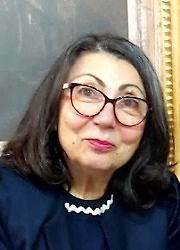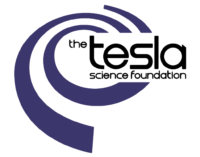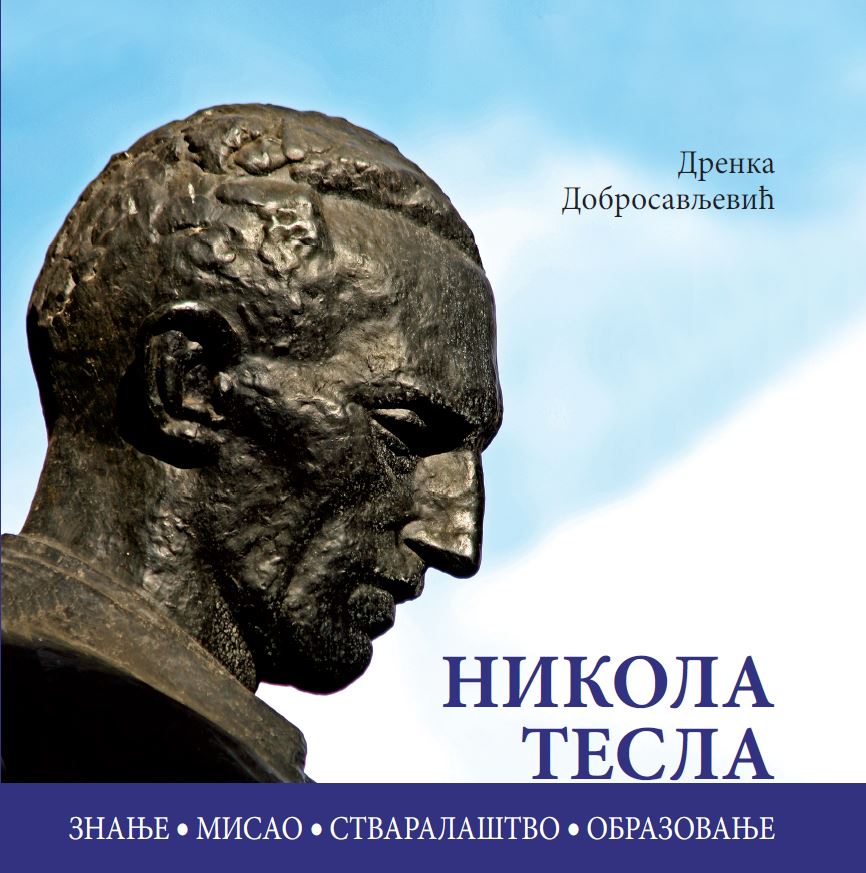 Drenka Dobrosavljević, Ph.D.
Drenka Dobrosavljević, Ph.D.
NIKOLA TESLA: KNOWLEDGE – THOUGHT – WORK – EDUCATION
On the occasion of the English edition of the book
Nikola Tesla (1856-1943): Knowledge, Thought and Work, Nikola Tesla’s Self-Education, with References to His Schooling, author Drenka Dobrosavljević, translation from Serbian Angelina Čanković Popović, editor Zoran Koludžija, for the Publisher, Korana Borović, published by Prometej, Novi Sad, 2023.
One of the rather difficult tasks for any researcher and author is to choose excerpts or a short chapter that would represent his/her book and rouse the potential readers’ interest in it. What should be selected from the contextual consideration of an extremely broad and voluminous material and from a multitude of information/data which had previously not been explained enough so as to make the selection (in the analysis provided by the book) simultaneously illustrative of the ever-present correlation between elements and data which is necessary for their appropriate understanding, for the necessary hermeneutic approach to the object of research? In the book presented herein, it is Nikola Tesla’s knowledge, the ways in which he acquired it, which types/fields of knowledge he gained, whether and to what extent he relied thereon, what characterized schooling – and higher education in particular – and the scientific thought before and during his time; moreover, it is our insights into the interactions between Nikola Tesla’s knowledge, his thought, his work and his education.
For this challenge and, above all, the incentive to participate in this event by an illustrative part of the text from my book, my acknowledgment is due to Mr. Nikola Lončar, President of Tesla Science Foundation. The book in question is Nikola Tesla (1856-1943) : Knowledge, Thought and Work : Nikola Tesla’s Self-Education, with References to His Schooling, Novi Sad : Prometej, 2023. Namely, following the 2022 Serbian edition of my book – in the year when the respectable Publisher won the title of the ’Publisher of the Year’ (2022) at the International Book Fair in Belgrade for the second time – the book has appeared in its English edition in a distinguished translation by Mrs. Angelina Čanković Popović, translator of scholarly and literary works.
The invitation I have received regarding presentation of my book through a fragment of my own choice has also given me the opportunity to express my gratitude to whoever took part in the preparation of this edition, including the individuals whose names are part of the colophon and of the layout-and prepress team. Likewise, the invitation has given me the chance to express my respect for the two golden medals awarded me in 2023 for the scientific/research works about Nikola Tesla: Tesla Science Foundation Medal – Tesla Spirit Award (Belgrade, July 2023), and a Golden Medal of the International Festival of Innovation, Knowledge and Creations – Tesla Fest (Novi Sad, October 2023). Naturally enough, comprehensive studies are always deeply rooted in and undergo a process of ripening through a number of papers/projects and researches over a longer period, and that has been the case with my research work on Nikola Tesla for more than three decades. On this occasion, I have to mention two scientific papers of mine that preceded and, in a way, led to this book: “Nikola Tesla’s self-education (with references to his schooling)” for Conference Proceedings. Schooling and Self Education of Nikola Tesla, editor Danko Plevnik, Karlovac: Association of Nikola Tesla Karlovac, 2019, 32-144, as well as – a year before – “Searching for the Reality: Contacts, Dialogues and Cognitive, Cultural and Sociocultural Mobility. Case Study: Nikola Tesla”, Phlogiston, 26 (2018): 9-32, both translated from Serbian by Angelina Čanković Popović. As to my book Nikola Tesla (1856-1943): Knowledge, Thought and Work: Nikola Tesla’s Self-Education, with References to His Schooling, a review has been published thereof, written by the historian and philosopher of natural sciences and technologies Dr. Dragoljub Cucić, professor of physics and Director of Mihajlo Pupin Center for Talents in Pančevo: it has appeared in the latest issue (31/2023) of the Journal for History and Philosophy of Science and Technology Phlogiston.
For the web portal TSF / TNFS I have chosen to contribute the full text of the chapter “Knowledge, Scientific Principles – the Principles in Physics, Mathematics, the Method and Mental Elaborations“.
Knowledge, Scientific Principles – the Principles in Physics, Mathematics, the Method and Mental Elaborations
“The vision was clear enough but the knowledge of principles was very limited. In one of my inventions I proposed to convey letters and packages across the seas, thru a submarine tube, in spherical ontainers of sufficient strength to resist the hydraulic pressure. (…) Another one of my projects was to construct a ring around the equator which would, of course, float freely and could be arrested in its spinning motion by reactionary forces, thus enabling travel at a rate of about one thousand miles an hour, impracticable by rail. (…) Still another scheme, far more important and attractive, was to derive power from the rotational energy of terrestrial bodies. I had discovered that objects on the earth’s surface, owing to the diurnal rotation of the globe, are carried by the same great change in momentum which could be utilized in the simplest imaginable manner to furnish motive effort in any habitable region of the world. I cannot find words to describe my disappointment when later I realized that I was in the predicament of Archimedes, who vainly sought for a fixt point in the universe.“ [i]
Nikola Tesla
What was the “predicament of Archimedes“ Nikola Tesla had in mind in the said comparison?
An attempt to provide an answer deserves some attention, for, once we analyze other Tesla’s writings in which he resorted to comparisons or allusions we can see that he never changed the original meaning of such references. We can also realize that by analyzing the particulars which tell us about Tesla’s reading and the insights/knowledge he could gain through self-education: that is what the next chapters deal with in more detail.
Now let us go back to the said quotation and Archimedes as mentioned therein. As to the “fixt point“, one may think that Tesla alludes to the sentence “Give me a lever and a fulcrum on which to place it, and I will move the earth“ reportedly uttered by Archimedes and referring to the “law of the lever“ he had discovered and proved in the treatise “On the Equilibrium“. The comment is broadly conveyed as a legend too, yet only at a symbolical level, without any hint to possible Archimedes’ pretense to expose the law of the lever within the context of astronomy and its laws. Which means that he did not find himself in a “predicament“. A record about the issue is found in Plutarch’s life-history of the Roman consul Marcus Claudius Marcellus, where he wrote about Archimedes and the situation in Syracuse during Marcellus’ attempts to capture the city, which he eventually did.
“Archimedes, however“, Plutarch recorded, “in writing to King Hiero, whose friend and near relation he was, had stated that given the force, any given weight might be moved, and even boasted, we are told, relying on the strength of demonstrations, that if there were another earth, by going into it he could remove this. Hiero being struck with amazement at this, and entreating him to make good this problem by actual experiment, and show some great weight moved by a small engine, he fixed accordingly upon a ship of burden out of the king’s arsenal, which could not be drawn out of the dock without great labor and many men; and, loading her with many passengers and a full weight, sitting himself while far off, with no great endeavor, but only holding the head of the pulley in his hand and drawing the cords by degrees, he drew the ship in a straight line, as smoothly and evenly as she had been in the sea. The king, astonished at this, and convinced of the power of the art, prevailed upon Archimedes to make him engines accomodated to all the purposes, offensive and defensive, of a siege. These the king himself never made use of, because he spent almost all his life in a profound quiet and the highest affluence. But the apparatus was, in most opportune time, ready at hand for the Syracusans, and with it also the engineer himself.“ [ii]
A “predicament“ related to the universe is found in Archimedes’ famed mathematical work titled The Sand-Reckoner[iii] or The Calculation of the Number of Grains of Sand in the Aristarchian Universe. In this work, Archimedes, in the introduction, deals with the issue of the universe and its centre[iv] from the prevailing geocentric view of the world as well as the heliocentric one of Aristarchus which presupposes a sphere of the fixed stars[v]. And to Archimedes himself, the Earth is the centre of the universe[vi]. However, this issue on the whole mattered to Archimedes only from the aspect of the mathematical problem he wanted to solve (and Nikola Tesla was certainly aware of that), because the premises of the Aristarchian heliocentric system proposed that the magnitude of the universe is multiply greater than proposed by the geocentric one.[vii] In his Sand-Reckoner, Archimedes aspired to present and prove that it was possible to calculate the number of the grains of sand regardless of the ratio, including the hypothetical issue of the quantity of sand needed to fill “even the universe of Aristarchus“. Moreover, Archimedes proposed in this work a system of his own for brief presentation/naming of large numbers[viii], which was something sought for by several Greek arithmeticians of his time[ix].
It is possible that, speaking of Archimedes’ “predicament“ and search for a fixed point in the universe, Nikola Tesla had in mind the introductory lines of The Sand-Reckoner wherein Archimedes unambiguously deferred to the prevailing geocentric system of the world.
There were other places and occasions which roused Tesla’s associations to Archimedes. It seems that the Inventor had studied all of the works written by Archimedes and those which described his life-history[x]; moreover, he used to study the works and biographies of whoever had left imprints on the history of scientific thought and invention – until his time, plus the history of philosophy, particularly natural philosophy.[xi]
Thoroughly educated and with an oustanding power of memorizing, and inclined to making syntheses, Nikola Tesla would lightly link his own messages to the details of the overall cultural heritage of the humanity or to some thoughts of philosophers, scientists, poets, fiction writers and religious thinkers. When he did so, he would mention their names or identifiable thoughts perfunctorily and in a familiar tone as if those had been just marginal syntagms, although the names were there as conveyors of Tesla’s essential messages. The same can be said of his many writings. It is this manner which accounts for our frequent lack of attention as to their revelatory role in the opportunity to take them as possible sources of information on Nikola Tesla’s self-education.
Now let us go back to the quotation at the opening of this chapter. Therein, Tesla describes his delight in the natural sciences, almost enchantment by the demonstrations of Professor Martin Sekulić. After graduation, during his year-long recovery from cholera in fresh air (as his father demanded), while roaming “in the mountains, loaded with a hunter’s outfit and a bundle of books“[xii], various inventorial ideas occurred to him, one after the other. At that point, Tesla discloses unambiguously that, before he enrolled in the studies at Graz, his knowledge of scientific principles had been very limited (which was quite natural, as he had just graduated from the secondary school). He also clearly expressed his opinion on ideas and visions if unfounded on knowledge, i.e. scientific education.
However much the secondary school, particularly the physics classes and demonstrations performed by his professor Martin Sekulić, had decisively reinforced Nikola Tesla’s intention to become an engineer and inventor, it was owing to the College (mere one step away from getting equal with universities) that Nikola Tesla completely understood that ideas were futile unless grounded on knowledge and scientific principles.
It is due to these insights, that we have the following opinion: Tesla’s statements about his use of his own power to visualize as a method did not imply his abnegation of the needed knowledge, familiarity with the principles in physics and with mathematics, for – it must be stressesd – as early as in his childhood, he had acquired the capacities of outstanding memory and mental calculation, owing to the exercises his father used to assign to him.
[i] Tesla, “My Inventions”, 34-35.
[ii] Plutarchus, Usporedni životopisi [Plutarch, Parallel Lives], Zagreb: Avgust Cesarec, 1988, 440. The translator of this book has taken over the English translation from “War Comes to Archimedes“, retrieved on Aug. 10, 2018 from https://physics.weber.edu/carroll/Archimedes/war.htm.
[iii] Archimedes, “The Sand-Reckoner”, in Thomas Little Heath: The Works of Archimedes, 221-232 (London: C.J. Clay and Sons, Cambridge University Press Warehouse, Ave Maria Lane, 1897). Retrieved 10. 08. 2018.
https://ia801408.us.archive.org/5/items/worksofarchimede029517mbp/worksofarchimede029517mbp.pdf.
[iv] Ibid., 222.
[v] The concept of the sphere of fixed stars was derived from the Aristotelian view of the world, which implied a static, motionless Earth in the centre of the cosmos and a multitude of celestial spheres above it, the ultimate one being – the sphere of fixed stars. In his treatise On the Heavens (De Caelo), Aristotle wrote:
“Since changes evidently occur not only in the position of the stars but also in that of the whole heaven, there are three possibilities. Either (1) both are at rest, or (2) both are in motion, or (3) the one is at rest and the other in motion. (1) That both should be at rest is impossible; for, if the earth is at rest, the hypothesis does not account for the observations; and we take it as granted that the earth is at rest. It remains either that both are moved, or that the one is moved and the other at rest. (…) The remaining alternative is that the circles should move, while the stars are at rest and move with the circles to which they are attached.“ Aristotel. O Nebu [On the Heavens], translated [into Serbian] by Milan Tasić (Beograd: Grafos, 1990), 55-56. [The Translator has taken over the English text from classics.mit.edu/Aristotle/heavens.2.ii.html; The Internet Classics Archive | On the Heavens by Aristotle, Book II, Part 8, translated by J. L Stocks] The concept of the fixed/immovable stars was maintained throughout classical thought and the age of Scholasticism, i.e. until Copernican Revolution.
[vi] Archimedes, ”The Sand-Reckoner”, 222.
[vii] In relation to that issue, Archimedes wrote: “Now you are aware that the ‘universe’ is the name given by most astronomers to the sphere whose centre is the centre of the earth and whose radius is equal to the straight line between the centre of the sun and the centre of the earth. (…) But Aristarchus of Samos brought out a book consisting of some hypotheses, in which the premises lead the result that the universe is many times greater than that now so called. His hypotheses are that the fixed stars and the sun remain unmoved, that the earth revolves about the sun in the circumference of a circle, the sun lying in the middle of the orbit, and the sphere of the fixed stars, situated about the same centre as the sun, is so great that the circle in which he supposes the earth to revolve bears such a proportion to the distance of the fixed stars as the centre of the sphere bears to its surface.”Archimedes, “The Sand-Reckoner”, 221-222.
[viii]Archimedes, “The Sand-Reckoner”, 232.
[ix] Đulio Preti, Istorija naučne misli. Nauka od Talesa do Ajnštajna [Giulio Preti, The History of the Scientific Thought: From Thales to Einstein]. Translated from Italian [into Serbian] by Drenka Dobrosavljević, Beograd : Klub NT, 2002, 101.
[x] In his description of an episode from his childhood, when his family had just moved from Smiljan to Gospić, Nikola Tesla referred to an anecdote from the life of Archimedes in order to convey the excitement of the high officials and local people (and his own) gathered to see the demonstration of the town’s first fire fighting engine, witnessing his success in solving a technical problem. This is how he remembered the event: “When all the speeches and ceremonies were concluded, the command was given to pump, but not a drop of water came from the nozzle. The professors and experts tried in vain to locate the trouble The fizzle was complete when I arrived at the scene My knowledge of the mechanism was nil and I knew next nothing of air pressure, but instinctively I felt for the suction hose in the water and found that it had collapsed. When I waded in the river and opened it up, the water rushed forth and not a few Sunday clothes were spoiled. Archimedes running naked thru the streets of Syracuse and shouting Eureka at the top of his voice did not make a greater impression than myself. I was carried on the shoulders and was the hero of the day.“ Tesla, “My Inventions“, 30.
[xi] Dobrosavljević, “Searching for the Reality: Contacts, Dialogues and Cognitive, Cultural and Sociocultural Mobility. Case Study: Nikola Tesla“, 24.
[xii] Tesla, “My Inventions”, 34.

